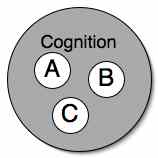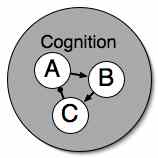The topic of the presentation was, essentially, to map out the ... big ideas ... that we're attempting to deal with when we do educational research from the cognitive perspective. I suppose that I should point out that we're all doing educational research within the sciences - I'm the only member focusing on Biology, while the rest of the folks are focusing on Physics. However, the nature of the domain of our study was not at issue, but rather the "30,000 foot view" of doing research on learning. While we discussed a number of issues, one of the most interesting to me was the subject of cognitive resources.
We all seemed to agree that cognition - thinking - has components, shown in Figure 1 as "A", "B", and "C".
 Figure 1 - Cognition Has Components
Figure 1 - Cognition Has ComponentsWe also agree, although more generally, that the components of cognition process information that is of a (somewhat) limited domain (though boundaries can be "fuzzy"), and that these components are linked to one another. Furthermore, we also agreed that the links between components can be either excitatory or inhibitory, and are generally directional. In Figure 2, these links are illustrated. I use a convention where lines that end in pointed arrows indicate an excitatory link, and where lines that end in circles indicate an inhibitory link. So, in this graph of cognition (Fig. 2), component "A" excites component "B", which then excites component "C", which then inhibits component "A".
 Figure 2 - Cognition Has Linked Components
Figure 2 - Cognition Has Linked ComponentsWe hit a bit of a bump in the road, though, as we begin to inspect the nature of the components of cognition. Existing literature (that we're familiar with...) would lead us to label these components of cognition as "resources". But yet, when I think about the resources that are necessary for the concept of evolution, I realize that those resources are in fact concepts. Interviews with other high school biology teachers confirms this notion. To paraphrase (*not* an exact quote, but close): "For students to understand the concept of evolution, they have to have a really good concept of genetics."
So, it seems pretty clear that there is some type of nesting that is happening with concepts and resources, such that a resource for one "big" concept (say, a big one like evolution in biology, or maybe quantum in physics) is a concept of its own. Now we can question whether this is a contextual effect - are we defining concepts *only* within a performance framework? Or is this a question on the nature of cognition - are some resources so tightly and stably linked that they form concepts that can act as resources for other, larger-domain concepts?
Furthermore, we realized during the presentation that some of us think of resources as components of cognition that can't be "unpacked" by the user - essentially highlighting the poor distinction between a resource and a "primitive" (such as diSessa's phenomenological primitives). Primitives tend to be described as highly automated, intuitive, and shallow processing components for cognition - a classic example is "closer means stronger", as in, "the closer I am to the fire, the hotter it feels." The models that we develop regarding thinking and learning will be affected by our interpretation of the components of cognition - if resources can only be primitive, then it will be very difficult for me to use the coordination class to describe the concept of evolution. However, if resources are sometimes primitive but sometimes concepts, we have to be much more specific about the actual nature of a resource, because the implication would be that all components of cognition are resources - which we then "tag" with classifiers such as "primitive" or "concept".
My feeling, which again is highly influenced by my own experience in teaching evolution to high school students, and from interviewing other high school teachers, is that all components of thinking are resources. Some resources are actually resourceful, and other resources are not - sometimes primitive resources are resourceful, and sometimes they are not. There are times when concept resources are resourceful, and there are other times when certain concepts are inappropriately incorporated into another, larger concept. I suspect that part of the resistence of some to think of primitives and resources as the same thing has to do with wanting the structure of a concept to be more complex than the structure of a resource. It here, in this debate, that I think the themes of biology can be applied to cognitive educational research in a way that significantly enriches the field.
In the biological domain, we inspect systems in two ways that are different but related: we look at both form and function. For example, biologists are concerned about the shape of DNA. Biologists are also concerned about the function of DNA. And to make things even more difficult, we look for an internally consistent relationship between form and function - the double helix shape of DNA help us to explain the process of DNA replication that allows heredity information to be passed on to another generation of organisms. Sometimes researchers know the form of a system before they understand the function, and sometimes it's the other way around. But in all cases, biologists seek a consistent and mutually beneficial relationship between the two. In cognition, we're limited because we are still learning about the form of thinking (and, in fact, the form of the brain), and we are still learning about the function and functional relationships between the structural components of thinking (and, in fact, the function and functional relationships of and within the brain). These are murky waters, indeed.
Our debate about the nature of primitive vs. resource vs. concept really illuminates our lack of specificity in our classifiers for the components of cognition - are we talking about form or function? And are our models for cognition inhibiting the relationship between form and function? We're also not being clear about the timescales that we're concerned about when we classify the components of thinking - and our intent has a lot to do with selecting the timescale that is relevent for our inquiry. If we're trying to explain thinking in-the-moment, we're likely to identify all active components of thinking as resources (regardless of utility in the form or function of an expert-level concept). If we're trying to explain student development of a concept across multiple instructional events, we're likely to disregard the spontaneously activated components (or, if we account for them, identify them as primitives) and identify components based on their formal and/or functional similarity to expert concepts.
So, what's a cognitive resource? My argument is that it's any active nerve or neural network that processes a limited domain of information in any instant of cognition. And then, what's a concept? My argument is that it's any group of linked cognitive resources in any instant of cognition. It is only in this model that I find satisfactory resolution of the pressures of related form and function, as well as describing knowledge (what is known in a particular instant in a particular context) and learning (developing concepts by changing the patterns of activation of resources and altering the relationships between those resources).
Finally, what's a p-prim? Well, it's a simple way of classifying the utility of a particular component of cognition - it is only a functional description, not a formal one (to say that the structure of "closer means stronger" or "dying away" is primitive indicates a primitive understanding of the brain and overlooks the necessity that even these processing elements have a complex internal mechanism). As such, I bid p-prims farewell, and choose to focus only on resources and concepts, because they can be analyzed both in form and in function.
Fare thee well p-prims indeed. I never really felt very comfortable with the idea of a p-prim. What is their point anyway? If they are only used in forming resources and contexts as needed? Meaning comes from the connections of resources within a specific context. p-prims as they are called are only a way of generalizing relationships, or specific pieces of knowledge. The specifics are what is important, and the connections to other pieces of information give meaning. A p-prim is almost a super control. We see things in the world around us, and we make sense through generalization. I see this as higher order thinking rather than a sub-level. In my field of computer science education, we have to look first at specific examples, and then find more and more ways to generalize the example so that it can be used in more ad more situations. This way of looking at it seems to be to be a bit more reasonable.
ReplyDelete